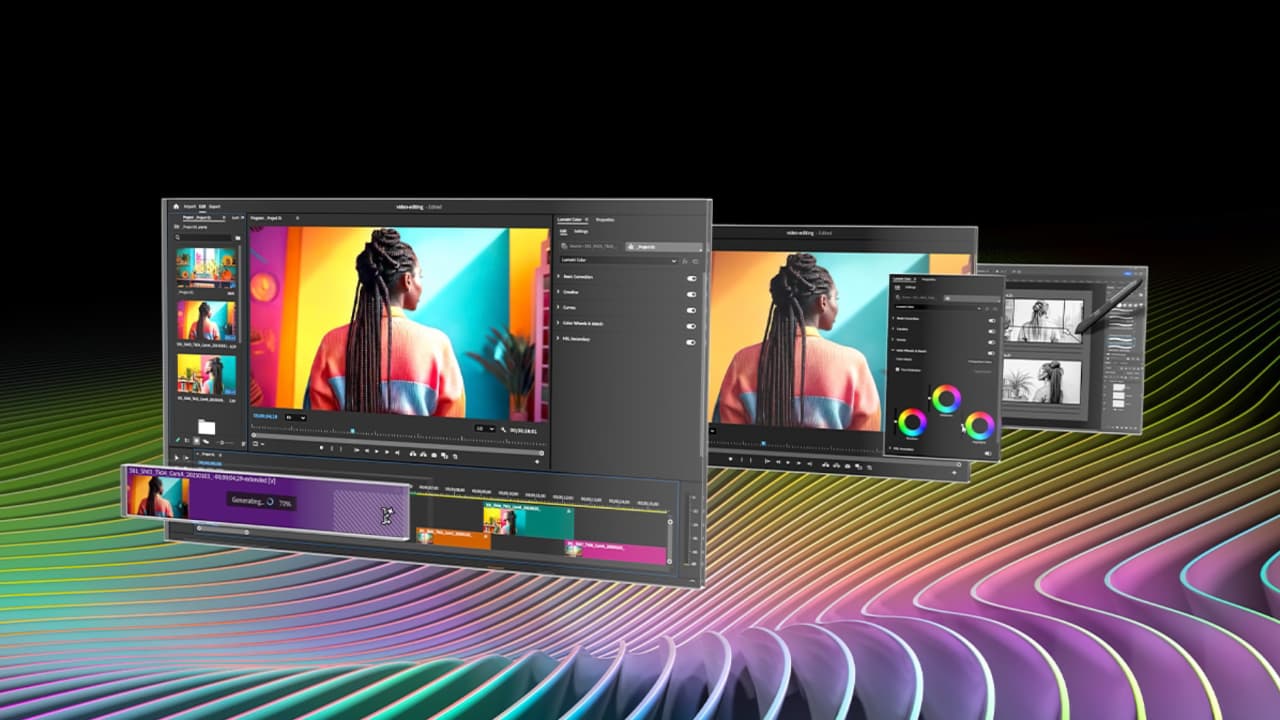
The new Nvidia GeForce RTX 50 Series GPUs feature up to three encoders for 4:2:2 video and FP4 for ramped up AI performance, plus new AI tools for livestreaming, DLSS 4 to boost 3D rendering, NVIDIA NIM microservices, and more.
Nvidia CEO Jenson Huang’s keynote was widely trailed and the new Nvidia GeForce RTX 50 Series GPUs were widely leaked and neither disappointed. These are seriously powerful chipsets with a huge performance boost over the previous generation and they’re going to ramp up video editing in particular.
Built on the NVIDIA Blackwell architecture, the GeForce RTX 50 Series GPUs can run creative generative AI models up to 2x faster in a smaller memory footprint compared with the previous generation. They also feature ninth-generation NVIDIA encoders for advanced video editing and livestreaming, and come with NVIDIA DLSS 4 and up to 32GB of VRAM to tackle massive 3D projects.
That 32GB of VRAM alone is a game-changer and is going to massively help anyone whose current 4090-based machines start to struggle when working on intensive tasks.
New video capabilities
Nvidia says that GeForce RTX 50 Series GPUs deliver a generational leap in its encoders and decoders with support for the 4:2:2 pro-grade color format, multiview-HEVC (MV-HEVC) for 3D and VR video, and support for the new AV1 Ultra High Quality mode.

4:2:2 video provides double the color information with just a 1.3x increase in RAW file size, offering an ideal balance for video editing workflows. The RTX 50 Series is equipped with from a single encoder and decoder to three encoders and two decoders at the top-end RTX 5090. Paired with faster GPUs, the multi-encode setups enable the RTX 5090, for example, to export video 60% faster than the GeForce RTX 4090 and at 4x speed compared with the GeForce RTX 3090, which is an impressive leap in just two generations.
The new GPUs also feature the ninth-generation Nvidia video encoder, NVENC, that offers a 5% improvement in video quality on HEVC and AV1 encoding (BD-BR), as well as a new AV1 Ultra Quality mode that achieves 5% more compression at the same quality. They also include the sixth-generation Nvidia decoder, with 2x the decode speed for H.264 video.
The company says it is collaborating with Adobe Premiere Pro, Blackmagic Design and DaVinci Resolve, Capcut, and Wondershare Filmora to integrate these technologies, starting in February. In other words, there’s a lot of potential souped-up editing performance just round the corner.
‘Unprecedented’ 3D rendering
As already mentioned, the GeForce RTX 5090 GPU offers 32GB of GPU memory — the largest of any GeForce RTX GPU ever, marking a 33% increase over the GeForce RTX 4090 GPU. This lets 3D artists build larger, richer worlds while using multiple applications simultaneously. Plus, new RTX 50 Series fourth-generation RT Cores can run 3D applications 40% faster.
DLSS 4 meanwhile debuts Multi Frame Generation to boost frame rates by using AI to generate up to three frames per rendered frame. This enables animators to smoothly navigate a scene with 4x as many frames, or render 3D content at 60 fps or more.
What does this mean in real world terms? We asked Richard Rogers, CEO and founder of renderboxes.com who has already been working on new machines that will be built around the new cards.
“For us the Nvidia RTX 5090 is a new opportunity to yet again highlight the importance of multi GPU in a workstation for increased productivity, less strain on actually creating and getting more of your work done quicker. So many times we hear new customers tell us their woes of how their machine slows down or is even unusable once they start rendering out projects or even making iterations, thus stumping their creative flow.
“The 5090 will offer 32GB of super fast GDDR7 VRAM providing a 33% increase over the GeForce RTX 4090 GPU, this will massively help VP artists that struggle in applications such as Unreal Engine and even Nvidia’s own Omniverse. Davinci Resolve alongside 3D applications can run up to 40% faster and will benefit hugely from these RTX 50 Series fourth-generation RT Cores."
Boosted livestream
Two new AI-powered beta effects are also being added to the Nvidia Broadcast app. Studio Voice enhances the sound of a user’s microphone to match that of a high-quality microphone. Virtual Key Light can relight a subject’s face to deliver even coverage as if it were well-lit by two lights.
The slight caveat here is that these features are currently recommended for video conferencing or non-gaming livestreams using a RTX 5080 GPU or higher. Nvidia says it is working to expand these features to more GeForce RTX GPUs in future updates.
The Nvidia Broadcast upgrade also includes an updated user interface that allows users to apply more effects simultaneously, as well as improvements to the background noise removal, virtual background and eye contact effects. The new version will be available in February.
Nvidia is also collaborating with Logitech’s Streamlabs and Inworld AI to create the Streamlabs Intelligent Streaming Assistant, “an AI agent that can act as a sidekick, producer and technical support,” that will be available later this year. Livestreamers can also benefit from the NVENC improvements — 5% BD-BR video quality improvement for HEVC and AV1 — in the latest beta of Twitch’s Enhanced Broadcast feature in OBS, and the improved AV1 encoder for streaming in Discord or YouTube.
And finally for this section, RTX Video is getting an update to decrease GPU usage by 30%, expanding the lineup of GeForce RTX GPUs that can run Video Super Resolution with higher quality.
Pricing and availability
The RTX 5090 will cost $1999, the RTX 5080 $999, the RTX 5070 Ti $749, and the RTX 5070 $549. The RTX 5090 and RTX 5080 GPUs will both be available on January 30, with the RTX 5070 Ti and RTX 5070 following in February.
RTX 50-series laptops will be available starting in March from a variety of PC makers. The RTX 5090 laptop GPU will debut with 24GB of GDDR7 memory, the RTX 5080 laptop GPU will ship with 16GB of GDDR7 memory, the RTX 5070 Ti with 12GB of GDDR7 memory, and the RTX 5070 with 8GB of GDDR7 memory. More details on them soon.
tl;dr
- The Nvidia GeForce RTX 50 Series GPUs feature up to three encoders for 4:2:2 video, FP4 for improved AI performance, and support for advanced video editing and livestreaming with Nvidia DLSS 4.
- Built on the Nvidia Blackwell architecture, these GPUs can run generative AI models up to 2x faster with a smaller memory footprint and come equipped with up to 32GB of VRAM, enhancing performance for intensive 3D projects.
- The new GPUs deliver significant improvements in encoding and decoding capabilities, including support for professional-grade 4:2:2 color format and multiview-HEVC for 3D and VR video, achieving faster export times compared to previous generations.
- Upcoming updates to the Nvidia Broadcast app will introduce new AI-powered effects for enhanced audio and lighting during streams, while collaborations with software companies aim to integrate these advancements into popular editing tools.
Tags: Post & VFX Nvidia


Comments